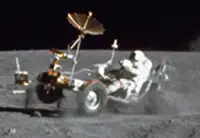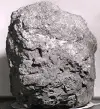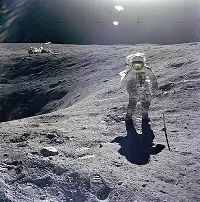Charlie Duke was a military pilot and astronaut who the 10th man to walk on the Moon. 
He was born on Oct. 3, 1935, in Charlotte, N.C. His family moved to Lancaster, S.C., where he attended Lancaster High School, then graduated top of his class at Admiral Farragut Academy in St. Petersburg, Fla., in 1953. Duke enrolled at the U.S. Naval Academy and left there four years later with a bachelor of science degree in naval sciences. He completed his studies at the Massachusetts Institute of Technology in 1964, with a master's degree in aeronautics and astronautics. After graduating from the Naval Academy, he received his commission into the Air Force, training at Spence Air Base and Webb Air Force Base. He completed advanced training at Moody Air Force Base and then served as a fighter interceptor pilot in West Germany, at Ramstein Air Base. A year after he completed his master's, Duke graduated from the Aerospace Research Pilot School and became an instructor and pilot there. In all, he logged more than 4,100 hours of flying time. The National Aeronautics and Space Administration (NASA) named Duke one of Astronaut Group 5 in 1966. He served as capsule communicator (CAPCOM) for Apollo 11, the first mission during which men walked on the Moon. Among his first words after Neil Armstrong walked on the lunar surface were these: "Roger, Tranquillity. We copy you on the ground. You got a bunch of guys about to turn blue. We're breathing again. Thanks a lot!" Duke was the backup Lunar Module Pilot for Apollo 13 and caused a shakeup in the primary crew when one of his children came down with rubella and he inadvertently exposed the primary crew to the disease. Command Module Pilot Ken Mattingly alone of all six members of the primary and backup crew had not suffered through the disease as a child and so had no natural immunity; as a precaution, NASA stood Mattingly down and replaced him with Jack Swigert. Duke and Mattingly were primary crewmates for Apollo 16. Duke and Commander John Young walked on the Moon. (Duke became the 10th and youngest person on the Moon.) As did the Apollo 15 crew, Young and Duke undertook extensive geological training, including field trips to various rock formations in New Mexico and in Canada. 
Launch date was April 16, 1972. One experiment that the crew performed en route to the Moon involved light flashes. Crews as far back as Apollo 11 had reported seeing light flashes in the dark of space, even when they had their eyes shut. The crew wore a special helmet that was designed to track the movements of cosmic rays. Subsequent analysis proved NASA's theory that the astronauts were indeed observing cosmic rays. The crew entered lunar orbit three days later. Young and Duke touched down in the Descartes region of the central lunar highlands on April 20 and stepped out in that order. They had landed later than planned because of a slight malfunction in the Command Service Module. That delay would result in less time on the Moon and a return home a day earlier than planned. 

The Lunar Roving Vehicle, unveiled on Apollo 15, again featured in the extravehicular activity (EVA) of the astronauts, allowing them to range farther from the spacecraft than ever before. They covered nearly 17 miles, exploring several craters, taking pictures, recording data, and taking samples of both dust and rocks. They returned with the largest Moon rock of them all, named Big Muley. Duke plucked the 26-pound rock from the surface and made sure it got back to Earth. They did three EVAs in all. On the third day, they did close observation of a giant rock that they named House Rock, proving that it was a breccia (meaning made of a collection of minerals), not the result of a volcanic eruption. 
Young and Duke spent 71 hours on the surface of the Moon; more than 20 of those were outside the Lunar Module. In some of their final minutes on the Moon, they decided to compete in a bit of Moon Olympics. (The year in which they were on the Moon, 1972, was an Olympics year: The Summer Olympic Games were Munich that year.) Among Duke's feats was a high jump of 4 feet off the lunar surface. He had not practiced such a thing and twisted a bit in mid-air and fell over when he landed, bouncing on his backpack; fortunately, he did not crack the suit or the life support system. Duke left behind a photo of his family. The trip home was uneventful, and they splashed down on April 27. He retired from NASA in 1975 and joined the Air Force Reserve. He achieved the rank of brigadier general in 1979 and retired in June 1986. He went into business in the private sector. Among his post-NASA responsibilities is as chair of the Astronaut Scholarship Foundation. Duke married Dorothy Claiborne in 1963. They have two children and nine grandchildren. |
|
Social Studies for Kids
copyright 2002–2025
David White




